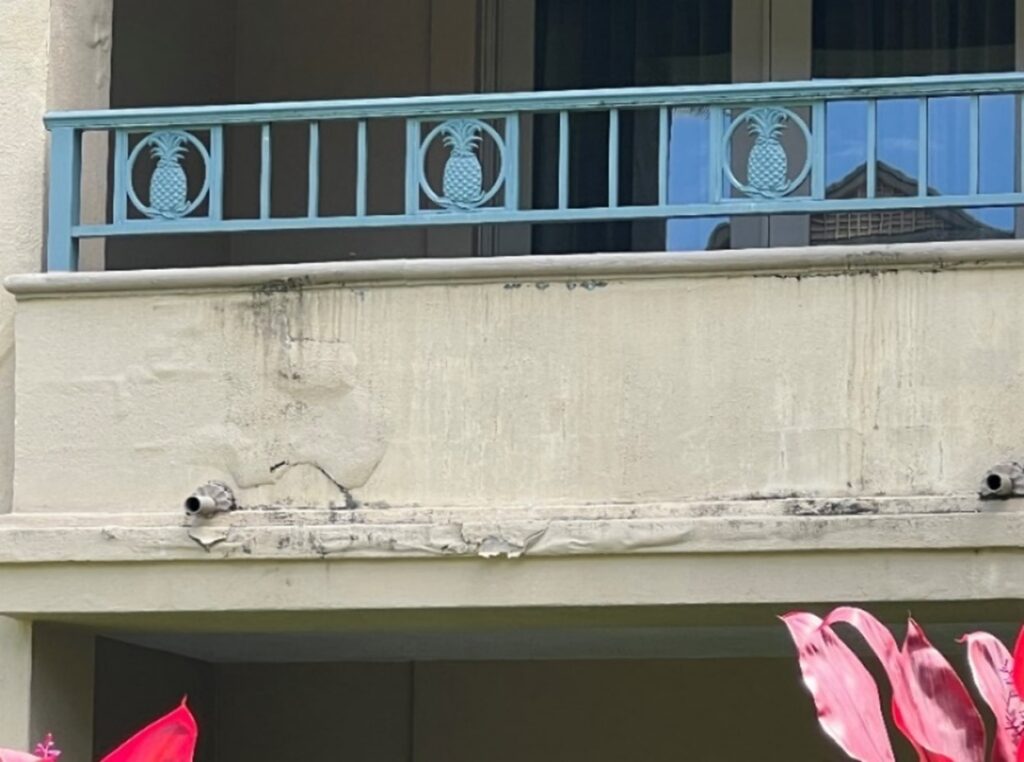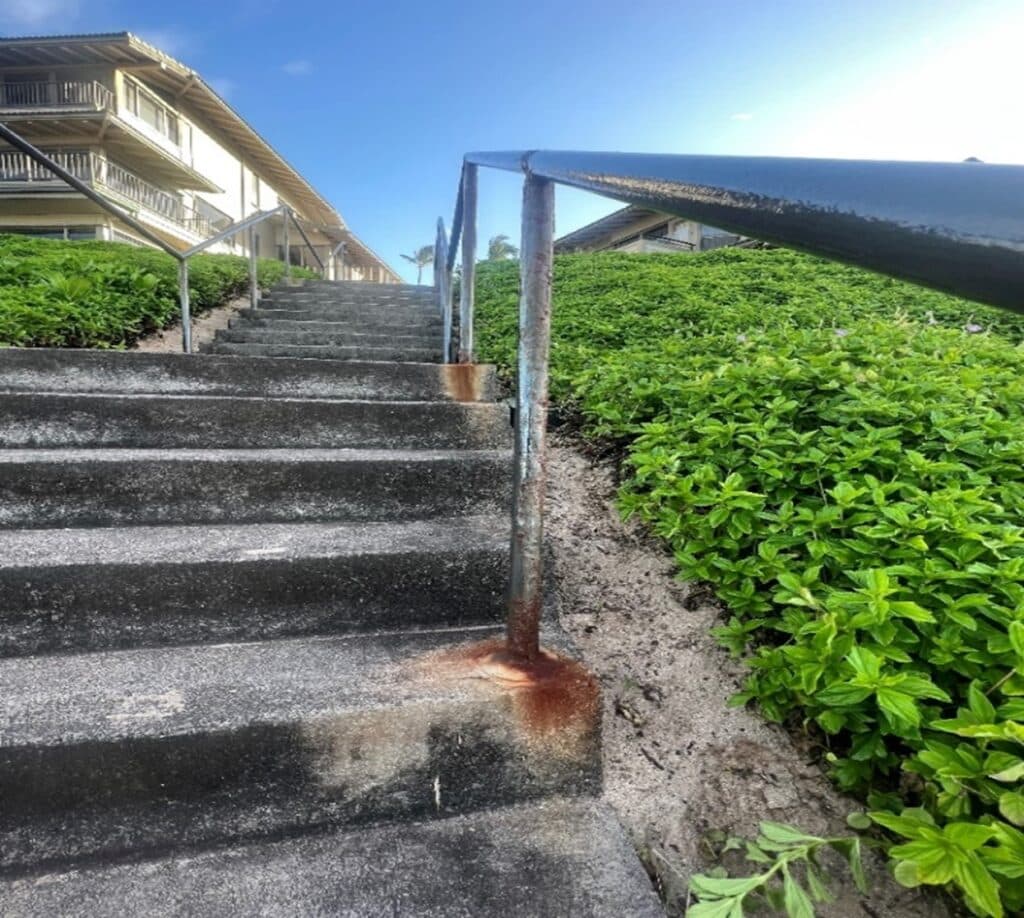by Thomas Lether | Jul 16, 2023 | Construction Law, Events, News & Updates
Building failures can result from a number of causes. A failure can be explained as much by weather as bad construction. For example, ice dams resulting in water and roof damage are common in colder regions. As a result, it is essential to be aware of the interaction between construction deficiencies and the environment in order to address weather-related failures.
The takeaway in many instances is that certain types of construction do not work in certain weather conditions. This is readily apparent in the tropics. For example, wood frame structures are subject to failure in regions of high heat, rain, and humidity. Steel or concrete construction is preferable.
Another example is the improper use of stucco in a tropical green environment. Exposure to marine air, salts and elevated temperatures can cause effervescence in stucco and concrete requiring the replacement of the entire building envelope.

Another everyday exposure in tropical climates is marine oxidation of exterior metal. Systems such as window frames, window door frames, and metal hardware exposed to salt, marine air and high heat routinely corrode. Finally, temperature inversion, the relationship between hot outside air and interior air cooled by air conditioning and HVAC systems can lead to numerous defects.

For all these reasons, it is essential to consider what building materials and types of construction should be used in tropical conditions.
Lether Law Group’s Hawaii Office Is currently involved in several construction defect matters in Hawaii. We are proud to have several attorneys born or raised in Hawaii and licensed to practice there.
Lether Law Group has the advantage of over 35 years of construction insurance coverage and litigation experience, coupled with local know-how and an affinity for Hawaii.
If you are involved in any construction claims in Hawaii or other tropical zones, feel free to contact us with any questions.
by lether law review | Aug 13, 2019 | Construction Law, Decisions, Insurance Law
Although not as liberal as the Washington courts, the Oregon courts have not necessarily been kind to liability insurers in coverage disputes arising out of construction defect claims. In a recent federal court ruling, however, the court has clearly held that construction defect claims resulting in breach of contract are not covered occurrences in Oregon. Moreover, the court held as a matter of law that claims for delay damage did not constitute property damage. The H.D.D. Company, Inc. v. Navigators Specialty Insurance Company, United States District Court for the District of Oregon, Case number 3:19-cv-00115-BR.
In the H.D.D. matter, H.D.D. was the subcontractor retained by SNC Lavalin Constructors to work on a natural transmission pipeline as part of the expansion of the underground natural gas reservoir. During the course of the project, a dispute arose as between H.D.D. and SNC. This dispute involved a retention of payments allegedly owed by SNC to H.D.D. and claims of alleged delay in completion of the subject work. As part of this dispute SNC demanded arbitration under the construction contract with H.D.D. H.D.D. then tendered the defense of the arbitration to Navigators who denied coverage on the basis that the claim did not involve an occurrence, that the claims did not involve property damage and that there were additional exclusionary exclusions which precluded coverage. H.D.D. subsequently sued Navigators. All parties to the action brought Cross-Motions for Summary Judgment for coverage issues.
The United States District Court for the District of Oregon denied H.D.D.’s Motion for Summary Judgment and found in favor of Navigators on its Motion. The court relied upon a long line of Oregon cases involving insurance coverage in the construction defect arena. The court concluded that Navigators had no duty to defend or indemnify H.D.D. H.D.D.’s primary arguments were that based upon the four corners of the Complaint there was a potential for coverage because the allegations could be read in such a way as to create a potential or plausible claim against H.D.D. Navigators argued that the claims set forth in the Complaint only asserted claims for breach of contract and delay which did not constitute an occurrence or property damage. The court agreed.
The court specifically held:
“A commercial general liability policy is not a warranty or performance bond for a contractor’s workmanship…. The risk being insured by such policies is the risk of tort liability for physical damages to others, and not contractual liability because the insured’s product is not at the quality for which the damaged person bargained…. When a Plaintiff alleges only breach of contract, there is not an “accident” within the meaning of the liability policy, and, therefore, there is not coverage under the policy.” (Internal citations omitted).
As a result, the court found that the alleged breach of contract in this case did not constitute an occurrence. In regard to the delay claims, the court also expressly held that such claims did not meet the definition of property damage. Despite the definition of property damage that includes loss of use language, the court still found that the loss of use has to arise from resulting covered property damage and not simply the insured’s defective work. The court expressly held that delay and increased construction costs that are the result of the defective component of the work performed by the insured does not constitute physical injury to, or loss of use of, tangible property.
The H.D.D. decision is a milestone decision in the Oregon courts in regard to both the issues of what constitutes an occurrence and what constitutes property damage under a liability policy.
Lether & Associates represented Navigators in the H.D.D.decision. We were pleased to be able to obtain this result and resolve this claim. If you would like to discuss this claim or other insurance disputes in the Northwest please feel free to contact our offices.
by lether law review | Sep 12, 2017 | Construction Law, Events, News & Updates
Tom Lether is proud to once again be the chairperson for the Seminar Group’s Insurance in the Construction Industry Law seminar. This two-day event, which Tom has chaired for the last 4 years, is this year focusing particularly on insurance issues involving the construction industry. The speakers include a number of experienced attorneys from both sides of the industry, a panel discussion with active Superior Court judges and a mock negotiation involving stipulated settlement issues. The two-day seminar on insurance in the construction industry will allow attendees to gain a better understanding of the wide variety of insurance issues involving construction law. The seminar is particularly timely given the current construction boom throughout the Northwest Region.
We look forward to having you join Tom and the rest of the speakers for this presentation.
To view the full agenda and register visit:
http://www.theseminargroup.net/seminardetl.aspx?id=5749
by lether law review | May 14, 2017 | Construction Law, Decisions, News & Updates
The Court of Appeals of the State of Oregon issued a decision on May 10, 2017 in the matter titled Hunters Ridge Condominium Assoc. v. Sherwood Cross, LLC, et al. that could potentially impact future Construction Defect cases in Oregon.
The Hunters Ridge appeal arose out of construction defect lawsuit. The Plaintiff Condo Association filed suit against the developer and general contractor. The general contractor then filed third-party claims against several subcontractors.
One subcontractor, Walter George Construction (“WGC”), was insured by American Family (“AmFam”). WGC tendered the claim to AmFam, who denied coverage based upon a Multi-Unit New Residential Construction Exclusion. Thereafter, WGC failed to appear or answer the Complaint.
Default Judgments were entered against WGC by the developer and general contractor, which included damages, attorneys’ fees, and costs. The remaining parties settled. The developer and general contractor, as part of their settlements, assigned claims against WGC to the Plaintiff Condo Association.
A Garnishment Proceeding followed, during which the Condo Association sought to obtain the proceeds of the applicable AmFam policy. Several Motions for Summary Judgment were filed. Those orders formed the basis of the appeal.
The Trial Court had granted AmFam’s Motion for Summary Judgment on the application of the Multi-Unit New Residential Construction Exclusion. On appeal, the Condo Association argued the exclusion was ambiguous and therefore could not be construed in favor of coverage.
The subject condo was mixed use – each of the three buildings had dedicated commercial space on the ground floor with residential units above them. The exclusion defined “multi-unit residential building” as “a condominium, townhouse, apartment or similar structure, each of which was greater than eight units built or used for the purpose of residential occupancy.”
AmFam argued that the condos, which contained more than eight residential units, were subject to the exclusion. On appeal, the Condo Association argued the exclusion was unenforceable for ambiguity. It claimed the exclusion could be read to either include or exclude multi-purpose buildings. The Court of Appeals agreed. Specifically, the Court determined the term “residential building” could be interpreted as either a multi-use building, or one that is purely residential. In light of the ambiguity, the Court reversed the Trial Court’s grant of summary judgment on that issue.
The Court of Appeals also reviewed the Trial Court’s denial of AmFam’s Motion which argued there was no coverage for attorneys’ fees and costs awarded in the underlying judgments.
The awards of fees were based upon the contractual indemnity provisions in the subcontracts, which obligated WGC to indemnify both developer and general contractor. The Trial Court held that the term “costs taxed against the insured” was ambiguous with respect to whether it included attorneys’ fees. AmFam appealed.
The Court of Appeals reviewed the fees in two ways. First, whether the fees were part of the “obligation to pay damages because of ‘property damage’ which the insurance applie[d].” Second, whether the fees constitute “costs” under the “Supplementary Payments” provision.
The Court determined that attorneys’ fees and costs can potentially constitute covered damages. The Court recognized that, under Oregon common law, when attorneys’ fees are claimed as consequential damages as a result of tortious or wrongful conduct by a defendant which causes a plaintiff to litigate with a third party, the standard American Rule does not apply.
The Court found that since the claims against the developer and general contractor arose in part from the WGC’s defective work, the insured was therefore liable for some portion of the fees incurred in defending those claims by the Condo Association. The Court concluded that such fees could qualify as consequential damages recoverable against the insured, even in the absence of a contractual indemnity provision. As consequential damages, the Court reasons, they could be considered “damages because of property damage” within the meaning of the policy.
The Court notes, however, that fees incurred by the developer and general contractor in litigating claims directly against the insured would not qualify as such “damages.” Such fees are not subject to the third-party litigation rule set forth above.
The Court did, however, determine that the fees incurred by the developer and general contractor in pursuing the insured directly may qualify as “costs” under the “Supplementary Payments” provision. The Court reasoned that since “costs” was not defined, it was required to interpret that term with the use of dictionary definitions. The Court found that the common definitions of the term “costs” could be construed to either include or exclude attorneys’ fees. Therefore, the Court held that the term was ambiguous, and ruled in favor of coverage. As a result, the term “costs” was construed to include attorneys’ fees, as well as expert expends, and the Trial Court’s denial of AFM’s Motion for Summary Judgment was upheld.
In addition the issues discussed above, the Court of Appeals reviewed the constitutionality of denying an insurer the right to a jury trial in the context of a Garnishment Proceeding. ORS 18.782 provides that, in a contested garnishment hearing at which the garnishee’s liability is determined, “[t]he proceedings against a garnishee shall be tried by the court as upon the trial of an issue of law between a plaintiff and defendant.” AmFam contended that this statute violated its constitutional right to a jury trial, pursuant to Article 1, Section 17 of the Oregon Constitution.
The Court agreed, and held that the insurer must be given the right to a jury trial as part of a full opportunity to litigate any coverage issues. As a result, the Court found that ORS 18.782 is unconstitutional to the extent it compels parties to a garnishment action to litigate coverage issues to the Court without the ability to elect a jury trial.
This decision obviously impacts several areas of law concerning insurance in the State of Oregon. If you have any questions or concerns about how this decision may impact any pending or future claims, please feel free to contact our office at any time.
by lether law review | Mar 11, 2017 | Construction Law, News & Updates
On August 17, 2017, the Washington State Supreme Court denied a Motion for Reconsideration of its April 27, 2017 decision in Xia v. ProBuilders Specialty Ins. Co., 188 Wn.2d 171, 393 P.3d 748, 2017 Wash. LEXIS 443, 2017 WL 1532219 (Wash. Apr. 27, 2017)
As we reported in April, the Xia decision is the first Washington appellate court decision to apply the “efficient proximate cause” rule to third-party liability insurance claims. Shortly after our initial report, the insurer, ProBuilders, filed a motion asking the Supreme Court to reconsider its decision. That motion has now been denied.
The Xia Plaintiff purchased a home built by Issaquah Highlands 48, LLC. Soon after moving in, the Plaintiff began feeling ill and it was determined that an improperly installed exhaust vent had been allowing carbon monoxide into the residence. The Xia Plaintiff filed a personal injury lawsuit against Issaquah Highlands, which tendered the lawsuit to its liability insurer, ProBuilders Specialty Insurance Company.
ProBuilders denied coverage, including any defense obligation, on the basis of two exclusions – the “townhouse” exclusion and the “pollution” exclusion. The Xia Plaintiff and Issaquah Highlands entered into a consent judgment settlement in the amount of $2 million with a covenant not to execute and an assignment of Issaquah Highland’s rights against ProBuilders to the Plaintiff. The Plaintiff then brought a bad faith lawsuit against ProBuilders seeking a finding that ProBuilders acted in bad faith in denying the duty to defend.
The King County Superior Court entered summary judgment in favor of ProBuilders based on the townhouse exclusion. The Washington State Court of Appeals reversed that ruling, but found that the pollution exclusion nonetheless operated to preclude coverage. The pollution exclusion at issue specifically excludes coverage for any injury:
Caused by, resulting from, attributable to, contributed to, or aggravated by the actual, alleged or threatened discharge, dispersal, seepage, migration, release or escape of pollutants, or from the presence of, or exposure to, pollution of any form whatsoever, and regardless of the cause of the pollution or pollutants.
The Washington Supreme Court reversed the Court of Appeals, finding that the “efficient proximate cause” rule applies to the analysis of third-party liability coverage. The “EPC” rule has been applied for years in first-party property claims. The rule has never been applied to a liability claim.
The Supreme Court’s analysis begins with a discussion of its historic treatment of pollution exclusions and concluded that the loss at issue was in fact caused by a “pollutant” as that term is defined in the policy and by Washington law. However, the Supreme Court’s analysis did not stop with that conclusion.
Yet even if the court applies the exclusionary language correctly to the facts at hand, the analysis does not end. Courts must next consider, whether pursuant to established Washington law, the excluded occurrence is in fact the efficient proximate cause of the claimed loss.
Based on a review of the briefing submitted to the Supreme Court, it does not appear as though any party, nor any of the amici, argued that the efficient proximate cause rule was implicated by the subject claim. Nonetheless, the Supreme Court discussed the efficient proximate cause rule at length and ultimately concluded that the efficient proximate cause of the loss was not the pollution, but the initial negligent installation of the exhaust vent. Thus, the Court concluded that the pollution exclusion did not apply.
Like any other covered peril under a general liability policy, an act of negligence may be the efficient proximate cause of a particular loss. Having received valuable premiums for protection against harm caused by negligence, an insurer may not avoid liability merely because an excluded peril resulted from the initial covered peril.
Having concluded that the loss was not excluded, the Court further found that ProBuilder’s denial was made in bad faith because it had failed to consider the efficient proximate cause rule or the Washington Supreme Court’s prior precedent admonishing insurers against attempting to include policy language that would potentially circumvent the rule.
As a result of these finding, ProBuilders is now facing a substantial judgment that not only includes the $2 million consent judgment, but also potential additional extra-contractual damages, interest, and attorney’s fees.
The impact of the Xia decision beyond the specific context of the application of the pollution exclusion may be significant. The decision also begs the question of whether pollution exclusions are ever enforceable in this jurisdiction. After all, nearly all “property damage” or “bodily injury” caused by pollution can be traced back to some prior act of negligence. These issues will no doubt by the subject of litigation in the lower courts for years to come.
Once again, as we initially noted following the Supreme Court’s decision, the most immediate lesson that may be gleaned from the Xia decision is the importance of defending under a reservation of rights and bringing a declaratory judgment action where coverage is questionable for a liability insurance claim. Had ProBuilders defended it could have substantially minimized its exposure while also maintaining the right to seek a judicial determination of its coverage obligations.
The fact that the Supreme Court entertained a Motion for Reconsideration offered a hope that the Court would reverse its application of the efficient proximate cause doctrine in the third-party liability context. The denial of reconsideration quashed that hope and Xia is now clearly Washington law. Insurers in Washington should be very wary of any declination of coverage, especially one involving the duty to defend, based on a third-party liability exclusion. Any such decision must take the Xiaanalysis into consideration.
If you would like to discuss the Xia matter in further detail, please feel free to contact us at any time.



